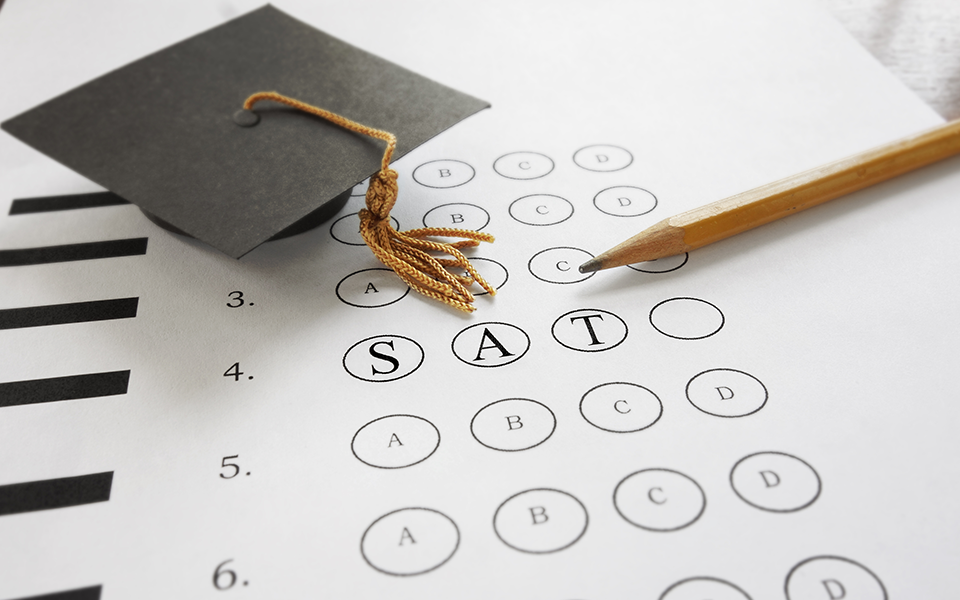Guide to US Applications • Undergraduate
Understanding the New SAT
POSTED ON 04/23/2017 BY The Red Pen

When The College Board announced they would be transitioning to a new format for the SAT starting in March of 2016, it set off a flurry of questions for applicants worldwide. Updates in 2005 and 2009 included radical changes to the format, additions to the writing section, an expanded mathematics section and shifting of the score range from 1600 to 2400. Now, the test format has returned to an optional writing section, rather than a mandatory one, a new philosophy behind the mathematics section and the score range has returned to 1600.
But beyond that, the test itself has a different ethos, which could be confusing to applicants worldwide. Many worried that this new version would once again overturn testing standards and put certain applicants at a disadvantage. The logic behind this re-design, however, at least as the College Board explains it, was to make the test a better reflection of the way students learn and truly assess their college-preparedness.
To give you a better sense of the new test, we talked to two popular test preparation companies, one in India and the other in the United States.
Here is a summary of what we have gleaned about the new SAT:
What are some of the biggest differences in the format of the test and how should applicants respond to it?
The new SAT is easier for international applicants as it doesn’t have a vocabulary component. While earlier incarnations of the SAT, applicants had to deal with word lists and vocabulary cramming, this new format cuts short preparation time. Therefore, someone who isn’t naturally good at English has a much better chance of doing well on this new test.
One of the test prep experts we talked to was pleasantly surprised to find that applicants seem to enjoy the new SAT a bit more than the old SAT. Apparently, the elimination of the “Fill in the Blank” vocabulary section and the overhaul of the grammar section to now focus on context, align better with the skills that students pick up in their everyday reading and writing.
What about the optional essay section? How should students approach that?
International applicants with good writing skills or students from the IB curriculum might see this as an opportunity to highlight their writing prowess. At the same time, applicants who are less inclined to writing or who study a curriculum where writing is less emphasised are now able to skip a section that might not help them perform well.
Does the test really correspond to the way students learn in class? Do applicants from different educational backgrounds respond to it in different ways?
The College Board focuses on engineering an exam that predicts college performance, primarily first-year college GPA, by tracking several metrics. While it is too early to predict trends in how applicants from different backgrounds respond to the new SAT, overall, they seem more comfortable with the writing and mathematics sections in this new test version. The writing section has shifted to a context-based approach and everything is in a passage/paragraph format, while the mathematics section is noticeably less reliant on trick questions and complicated word problems. Also, unlike the earlier SAT, which comprised 60 percent geometry, algebra is now a cornerstone in the new test, which helps many applicants.
The best thing about this new format, experts agree, is that there are no surprises. This means that applicants who prepare well, do well!
What challenges do international applicants specifically face in the new testing format?
While the writing and language sections have become much easier for applicants from all backgrounds, the reading section presents some specific new challenges.
International test-takers should think about how they prepare for the reading section. As a result of the shift away from magazine-style prose to passages with more elevated language, some international applicants might stumble with the language they are reading and analysing. For most passages, it’s much more important to be able to pick out the ‘main idea’ of each paragraph and passage. Applicants need to remember, it’s not about understanding every detail in the passage, rather it’s about being able to answer the questions quickly and correctly. Some applicants might benefit from having a rudimentary knowledge of American Civics and the history of race and gender in the United States, and reading historical government documents, such as the US Constitution, Gettysburg Address or the Federalist Papers. Any English works written between 1770 and 1890 will be useful for students. One expert recommended writings by Thomas Paine, Elizabeth Cady Stanton and Frederick Douglass, which are all available in the public domain, so finding them should be as easy as a quick google search.
As with everything, the more prepared applicants are, the better. Some Indian test prep experts feel that Indian applicants don’t spend enough time studying for the test, because instead of studying slowly over a period of three or five months, they give themselves one month of intensive preparation, which doesn’t serve them. The general recommendation is that applicants need between 150 to 200 hours to prepare for the test.
Both experts agreed, reading is essential, especially brushing up on some of the classics, or at least the abridged versions. If you want to do well on this test, you have to read. Period.
Finally, the latest news about the SAT is that The College Board has reduced the number of international test dates for SAT to only four per year. Previously the test was administered six times a year internationally. The SAT dates are now in October, December, March and May. Given that there are only 4 SAT dates, applicants who need to take the test will need to check their calendars and plan to ensure they have enough time to prepare and crack the SAT!
If you want to discuss test preparation options or need college admissions consulting services, get in touch with us.


